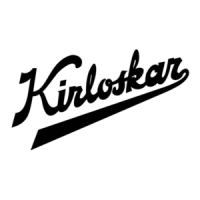What does warm suction side of H.P. safety mean for KIRLOSKAR KC9 Air Compressor?
- LLatoya GonzalezSep 13, 2025
A warm suction side of the H.P. safety indicates a leaking safety valve. Repair or replace the valve.

What does warm suction side of H.P. safety mean for KIRLOSKAR KC9 Air Compressor?
A warm suction side of the H.P. safety indicates a leaking safety valve. Repair or replace the valve.
| Brand | KIRLOSKAR |
|---|---|
| Model | KC9 |
| Category | Air Compressor |
| Language | English |
Guidelines and precautions for safe operation and maintenance.
Procedures for unpacking, lifting, and storing the compressor safely.
Procedures for routine inspection, servicing, and schedule.
Checks and preparation steps before initial compressor operation.
Details on the compressor's forced lubrication system.
In-depth breakdown of compressor parts and their construction.
Fundamental guidelines for operating the compressor.
Step-by-step guide for compressor startup and running.
Information on preventing damage from liquid refrigerant.
Safety precautions specific to ammonia refrigerant.
Steps before initial operation, including oiling and pressure checks.
Procedures for removing air and moisture from the refrigeration system.
Procedures for safely charging the system with refrigerant.
Detailed procedure for starting the compressor correctly.
How to adjust cooling capacity for single-stage models.
Guidelines for operating and controlling two-stage compressors.
Procedure for starting and loading two-stage compressors.
Guidelines for installing and operating multiple compressors in parallel.
Recommended maintenance tasks and their frequency.
Regular checks to ensure compressor health and performance.
Maintenance procedures for suction and discharge valves.
Inspection and maintenance of safety valves.
Critical guidance for compressor lubrication and oil management.
Function and importance of pressure switches (pressostats).
Identification and resolution of common compressor faults.
List of essential spare parts and how to order them.
Measures to avoid compressor failures caused by system dirt.
Identifying sources of contamination entering the compressor.
Methods to prevent system dirt from entering the compressor.
Specific steps to protect the compressor from contamination.
Critical checks required during compressor installation.
